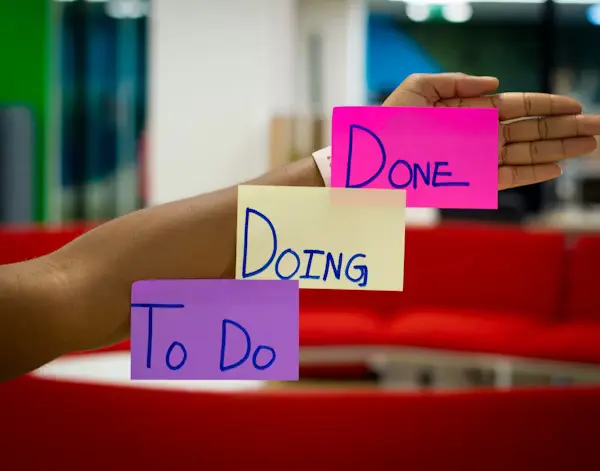Quick Look: What This Guide Offers You
Need to tackle tasks without feeling weighed down by guilt? This guide shows you straightforward steps to avoid putting things off. It explains the reasons behind procrastination, shares easy ways to overcome it right now, and provides a 30-day plan to turn small achievements into a lasting routine. It skips the empty motivational talk and offers tips you can use.
What Procrastination Means
Procrastination is not the same as being lazy. It works as a way to cope. When a job feels hard, risky, or unclear, your brain chooses quick comfort instead. This might turn into endless scrolling, snacking, or pretending to “research.” The main thing is figuring out if you’re avoiding the work because of emotions or handling it wrong.

Emotional and Strategic Avoidance
Emotional delay happens when fear, boredom, or stress makes a task feel overwhelming. Strategic delay takes place when a task lacks clear instructions or direction. Tackling emotional avoidance calls for tools that deal with feelings. Solving strategic avoidance means setting up a better plan and structure.
Chasing Quick Rewards
We live surrounded by endless temptation. Phone’s endless scrolling, and quick snacks give us instant gratification. The brain craves quick pleasures and ignores long-term benefits. To gain control, you need to stack the odds in your favor. Make it easier to do what’s productive and harder to get distracted.
Why Do We Procrastinate?
Understanding the basics lets you quit blaming yourself. Two systems in your brain compete. The limbic system chases pleasure now, while the prefrontal cortex focuses on planning and long-term goals. Procrastination happens when your limbic system gets the upper hand.
How Rewards Work in the Brain
Dopamine fuels the brain’s love for new stuff and quick rewards. Completing a tiny task triggers a small dopamine boost. That’s why small victories matter—they teach your brain to enjoy making progress.
Executive Function and Strength of Will
The brain’s executive function controls focus, makes decisions, and keeps impulses in check. It has limits. Stress and repeated decision-making wear it down. Telling someone to “just try harder” doesn’t work for long.

Why Strength of Will Isn’t Enough
Depending on willpower is like plugging a hole with your hand. It might help for a bit, but the pressure doesn’t stop. Instead of plugging, replace the pipes. Adjust your surroundings and routines so that using self-control isn’t as necessary.
Different Kinds of Procrastinators
To solve procrastination, figure out your type.
The Perfectionist
This type delays tasks because they feel nothing is ever quite right. They start late to dodge delivering something they find flawed.
The Avoider
Avoids tough tasks that cause stress. Chooses busywork instead of tackling the real problem.
The Thrill-Seeker
Puts things off to feel the last-minute excitement. Believes it works best under pressure, even if it doesn’t.
How to Shift Your Thinking
Changing how you think can lead to big results.
See Work as Practice
Treat tasks as ways to improve, not as life-or-death evaluations. Focus on learning so mistakes become lessons, not failures.
Prioritize Progress Over Perfection
Decide what’s “good enough” to move forward. Ask yourself what the smallest step is to keep going, then take that step.
Easy Steps to Take Right Now
Here are ideas you can put into action right away.
Simplify Steps: Break Tasks Into Pieces
Big tasks can seem impossible to tackle. Break them into smaller, easier chunks. Instead of saying “write the report,” make a list like: 1) create an outline, 2) write the introduction, 3) find three key quotes. These smaller steps make progress feel easier to achieve.
Act on the Two-Minute Tasks
Do tasks that take two minutes or less right away. This clears small things off your plate and frees up your mental space. It’s a small habit that can help you build momentum.
Use Time Blocks to Stay on Track
Schedule specific time slots in your calendar to focus on important work. Treat these blocks as if they were meetings you cannot skip. Plan 60–90 minutes for your intense work, while shorter stretches can cover smaller tasks. This keeps you structured and committed when it matters.
Pomodoro Technique
Work for 25 minutes, then step away for 5. Do this cycle four times before taking a longer break. Using a timer creates a sense of urgency, while breaks help you refocus.
Adjusting the Pomodoro Method
If 25 minutes feels too short, you can try working for 45 minutes and resting for 15. If interruptions happen, jot them down, and start fresh. The main goal is to match your rhythm.
Set Up Your Space
Create an area where doing what you need becomes the easiest option.
Eliminate Distractions
Move your phone to another room, block websites that pull your attention, or switch to a browser designed for focus. Keeping things out of view often keeps them out of mind.
Create a Starting Zone
Set up your workspace in a way that tells your brain it’s time to focus. Put just the essentials like a tidy desk, a water bottle, and a notepad. Follow the same routine each day before you begin—stretch, take a breath, and open your notebook. Doing it turns it into a habit.
Try Using Implementation Intentions
This small habit can lead to big results.
‘If-Then’ Plans To Follow
Say something like: “If the clock says 9 a.m., I’ll spend 30 minutes starting task A.” When you pair clear triggers with clear actions, it simplifies decisions and keeps you moving instead of hesitating.
Examples You Can Use Today
- “After I finish lunch, I’ll spend 20 minutes writing.”
- “When I sit at my desk, I’ll open the document and write the first line.”
These small habits make it easier to get started.
Control Your Mood and Energy
Sometimes energy matters more than motivation.
Simple Rituals to Get Going
Try a quick 2-minute activity to begin. Erase a line of text, set a timer, or jot down one point. Starting small makes things feel easier.
Eat, ,Rest Move
You’re not a robot. Good sleep, healthy meals, and quick walks help improve willpower and attention. When your energy dips, productivity tips won’t fix much. Start by getting the basics right.
Motivation Hacks That Work
Learn how to use the way the mind works to get things done.
Temptation Bundling
Combine something fun with an activity you avoid. Listen to your favorite podcast while doing boring paperwork like filing taxes. This way, the dull task feels less frustrating.
Small Rewards to Motivate Yourself
Treat yourself to something small after completing part of a task. It could be a cup of tea or a few minutes browsing a website you like. Little rewards help your brain link work to feeling good.
Staying Accountable With Others
Other people help way more than most realize.
Make Promises Public
Share your deadline with a friend or put it somewhere visible. Turning an intention into something others can see makes it feel like a group deal, not just your own thing.
Partner Check-ins and Study Sessions
Plan quick check-ins with someone. It could be as simple as saying, “I’ll work for 50 minutes and then update you.” These small commitments help you push through by adding just enough outside pressure.
Apps, Tools, and Routines
Systems matter more than the tools, but the right tools can make a difference.
Basic Task Lists
Stick to one clear list or an easy-to-use task app that tracks deadlines. Skip anything too fancy. The idea here is to stay organized without making it harder.
Tracking and Focus Helpers
Try website blockers, timers, or tools like habit trackers. Using visuals like checkboxes or tracking streaks can boost your motivation more than you’d think.
Habits and Stacking Them
Build progress little by little through consistent small habits.
Small Steps Lead to Big Wins
Pick a task so easy it feels silly. Example: “Open the project doc and write just one sentence.” Once you get started, push yourself to do more.
Example of a Habit Stack
- When I make coffee, I’ll open my project and work on it for five minutes.
- If those five minutes go well, I’ll keep going for another 15.
Bouncing Back from Setbacks
You’re bound to hit roadblocks. What matters is how you respond.
Rituals to Reset
Take a quick reset when you mess up. Spend one minute breathing. Write down what got in your way. Choose one small next step. Simple rituals help stop feelings of shame.
Learning from Mistakes
Look at a slip-up as a chance to learn. What set it off? What time was it? Use those clues to make adjustments for the next attempt.
A 30-Day Plan to Take Action
Steps you can stick to in order to improve procrastination habits.
Step-by-Step for Each Week
Week 1 — Start With Small Wins
- Choose one task you’ve been avoiding. Use the two-minute rule and try one 25-minute Pomodoro session. Track how you’re doing.
Week 2 — Create a Routine
- Plan three main work sessions each day. Begin each session by using “If-Then” statements. Try pairing your tasks with small rewards to stay motivated.
Week 3 — Lock in Your Habits
- Attach a small habit to something you already do, like spending 15 minutes writing right after breakfast. Check in with someone to stay accountable two times a week.
Week 4 — Build and Look Back
- Add more focused work time. Think about what went well and what didn’t. Celebrate finishing three major tasks. Create a fresh 30-day plan based on what was most effective.
Mistakes People Should Avoid
- Trying to change everything all at once.
- Thinking motivation is enough while ignoring effective systems.
- Keeping tasks unclear. Saying “work on a project” can mislead; saying “write 200 words” gives a clear goal.
- Skipping rest. Burnout often pretends to be procrastination.
Tracking Progress and Recognizing Wins
Keep an eye on basic measures. Notice tasks started, tasks completed, and how many focused sessions you managed in a row. Celebrate even small victories to keep the momentum alive. Reviewing each month helps highlight progress, like completing more tasks or reducing the habit of avoiding them.
Wrap-Up
Overcoming procrastination doesn’t require superhuman determination. It takes clever planning instead. Break big tasks into smaller, manageable pieces. Create clear start points, adjust your surroundings, and build small repeatable habits that build up over time. Use tools like timers, rewards, or accountability with others to stay on track. If you view procrastination as a series of fixable issues instead of a flaw in who you are, you can take charge. Start by forming one small habit today and let it lead to another. You will swap hesitation for routine, disorder for organization, and overwhelm for simple actions.
FAQs
Q1: What is the psychology behind procrastination?
Procrastination tends to be linked with managing emotions. People hold off on tasks not because they lack effort, but because those tasks make them feel uneasy—whether it’s boredom, stress, or fear. The brain leans toward quick comfort, like scrolling through social media rather than focusing on future rewards like completing the job. It works as a way to sidestep unpleasant feelings tied to the work.
Q2: Why do people procrastinate?
Procrastination grows from feelings like fear and doubt about oneself. People might hesitate because they fear failing, messing up, or even succeeding. Sometimes, a lack of confidence, bad time-management habits, or unclear tasks play a role, too. When a task feels confusing, the brain treats it like a problem to avoid instead of facing it.
Q3: What is the 2-minute rule in Atomic Habits?
James Clear explains the 2-minute rule in Atomic Habits as: “When you start a new habit, it should take less than two minutes to do.” The main idea is to begin with a simple step instead of trying to tackle the full habit. For instance, instead of saying “read every night,” decide to “open the book.” Or instead of aiming to “run ,” just “put on running shoes.” Starting becomes so easy it feels almost too simple not to try. That small first step often encourages you to keep going.
Q4: How can psychology stop procrastination?
Psychology has tools to fight procrastination. Changing how you think about tasks using cognitive-behavioral methods can help. For example, instead of telling yourself This must be perfect,” you can say, “This is just the first version.” Setting plans like “At 8 a.m., I’ll start project X for 10 minutes” makes action feel automatic. Breaking tasks into smaller chunks, keeping yourself accountable, and using rewards can motivate you to act rather than avoid.
Q5: How to teach a child not to procrastinate?
Teaching kids to overcome procrastination takes time and structure. Here’s how:
- Break tasks into simple steps. Instead of saying “clean your room,” try “put your toys into the basket first.”
- Stick to steady routines. Regular schedules help kids stay on track. Doing homework at a set time each day adds some stability.
- Make things enjoyable and rewarding. Turn chores into games or offer small rewards to recognize progress.
- Show them good habits. Kids watch what adults do. If they see you handling tasks right away, they’ll pick up the same attitude.
- Encourage instead of punishing. Focus on praising their efforts. This builds their confidence and helps them avoid being afraid of failing.
Having clear guidance shows kids that starting is less stressful than last-minute rushing.
